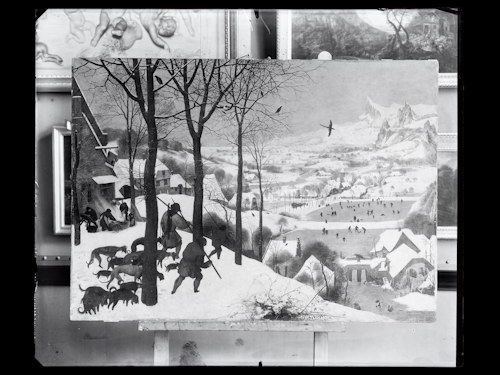
Taking high-quality archive photos of museum exhibits demands expertise and the appropriate technology. Imagine that task some 130 years ago. The Colour in Black and White exhibition at the Kunsthistorisches Museum (KHM) has the story.
- Presents Josef Löwy’s groundbreaking project to photograph the Imperial Painting Collection
- Includes models and juxtaposed photos & paintings
- Fascinating insight into a rare chapter of history and art
- All texts in English and German
- Runs Oct 28, 2022 – May 1, 2023
- See also:
- Current KHM overview & visitor tips
- Current art exhibitions in Vienna
Colour in Black & White

(Josef Löwy (1834-1902); glass plate negative of Hunters in the Snow, 1889, Pieter Bruegel the Elder (ca. 1525/30-1569); Kunsthistorisches Museum Wien, Picture Gallery; press photo © KHM-Museumsverband)
So you’re about to move the Imperial Painting Collection from Belvedere to the lovely new Kunsthistorisches Museum. Seems like an opportune moment to document the collection on film for posterity and publications.
Which would be fine except this is the late 19th century. We’re still around 30 years from Nikon beginning life as an optical instrument manufacturer in Tokyo. And 40 years from Canon doing the same.
Step forward one Josef Löwy (1834-1902), court photographer and technology pioneer. He won the contract to capture the paintings for a new illustrated edition of the collection catalogue.
Of course, the nature of the subjects meant the devil was (literally) in the detail.
The photos needed to be clear enough to represent the true majesty of the painters’ work, appeal to a wide audience, and satisfy the academic criteria of such a publication and those who might use the photographs for research.
Quite a challenge in a time when horses were still the main form of vehicle power.
The story and solutions feature in the Kunsthistorisches Museum’s small Colour in Black and White exhibition, #26 in the Point of View series that takes a deeper dive into art history.

(Design of the octagonal photographic pavilion at Belvedere before 1888; Kunsthistorisches Museum Wien, archive © KHM-Museumsverband)
We discover how Löwy set up a temporary outdoor studio with its own turntable and dark room, brought to life in the exhibition with drawings, a model, and a camera for which the word handheld most certainly does not apply.
The use of natural light, advanced techniques for capturing correct shades and hues, and Löwy’s perfectionist approach ensured remarkable quality in the subsequent photos taken across 1888-1891.
You can see this for yourself in the exhibition, which pairs actual paintings with the photos by Löwy.
Most intriguingly, different plates and prints illustrate how technology choices impacted quality quite significantly.
Natural light offered a huge improvement over indoor photography, for example. But material choices, customised to each specific painting, also played a huge role in how different colours emerged in black and white in the final photo.
The exhibition only takes a few minutes of your time, but you still come away with a clear understanding of the dedication, expertise and importance involved with this rare snippet of art history.
Dates, tickets & tips
Admire the work and vision of Josef Löwy from October 28th, 2022 to May 1st, 2023. A standard entrance ticket for the Kunsthistorisches Museum includes the Point of View exhibition.
Of course, the joy of the location is you need not rely on photographs to enjoy the priceless paintings by old masters. Simply wander into the museum’s picture gallery to enjoy your Rembrandts and Raphaels, Dürers and van Dycks.
For more photographic history, try the Westlicht centre. They have a collection of historical cameras that includes the world’s first commercially-available camera from 1839.
How to get there
Just follow the travel tips in the main KHM article. The museum is very central and on the traditional walking and tourist routes through the city.
Once through the main entrance, go straight ahead up the stairs and left, then around to the right (or just follow the signs).
Address: Burgring 7, 1010 Vienna